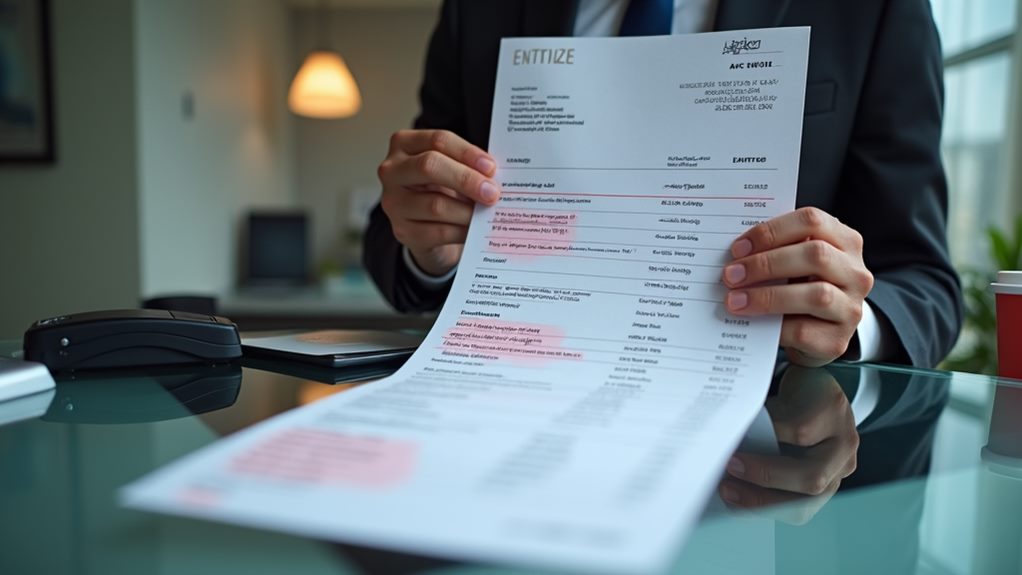Your VoIP business costs will depend on several key factors, starting with monthly service fees of £5-£40 per user plus line rental fees of £10-£50 per user. You'll need to budget for initial hardware investments, including VoIP phones (£35-£300 each), headsets (£20-£200), and ATAs (£100). Installation costs average £50 per extension, while reliable broadband service adds £15-£50 monthly. Factor in additional expenses like taxes and regulatory fees, which can increase your total by 20-30%. While these costs may seem substantial, VoIP systems typically reduce operational expenses by up to 60% compared to traditional phone systems. Let's explore how to optimize your VoIP investment.
VoIP Pricing Structure Breakdown

VoIP Pricing Structure Breakdown
Three main components make up the core pricing structure of business VoIP systems: monthly service packages, line rental fees, and hardware costs. VoIP technology greatly reduces operating costs for small businesses, providing an opportunity to save on overall communication expenses cost savings and affordability.
Your monthly cost will typically range from £5 to £40 per user for service packages, depending on which features you select. You'll also need to factor in line rental fees, which can add another £10 to £50 per user monthly.
When planning your budget, remember that providers often structure their pricing based on the number of users, so you'll want to accurately assess your team size.
For hardware, you'll need to invest in VoIP-compatible phones, which range from £35 for standard models to £300 for advanced executive versions.
Don't forget to include additional costs for headsets, which can run between £20 and £200 each. Initial setup costs vary among providers, and you might find some offering free setup when you commit to annual contracts.
Before finalizing your provider choice, make sure you understand the complete VoIP pricing structure, including any hidden fees or taxes. Your total investment will depend on your specific needs, chosen features, and the scale of your implementation.
Equipment and Hardware Costs
When planning your VoIP system's hardware budget, you'll need to account for desk phones ranging from £35 to £300 per unit, plus potential headset costs between £20 and £200.
To enhance cost-effectiveness, consider utilizing Analog phones with ATAs for a seamless integration into your VoIP network.
Your hardware requirements might include Analogue Telephone Adaptors (ATAs) at approximately £100 each if you're keeping legacy phones, while installation costs typically run around £50 per extension.
To guarantee excellent call quality, factor in potential broadband upgrade expenses of £15 to £50 monthly, as your existing connection may need enhancement to support VoIP traffic effectively.
Initial Hardware Investment Analysis
Implementing a VoIP system requires careful consideration of the initial hardware investment, which varies considerably based on your business size and needs.
Your hardware costs will typically begin with VoIP desk phones, starting at £35 for basic models, while dedicated VoIP phones with advanced features start from £39.99. Some businesses may also choose to leverage affordable communication solutions that optimize their costs further.
For team members who prefer headsets, you'll need to budget between £20 and £200 per unit, depending on the quality and features required.
If you're planning to integrate existing traditional phones, you'll need Analogue Telephone Adaptors (ATAs) at approximately £100 each.
When setting up an on-premise VoIP system, installation costs average £50 per extension. For perspective, a 20-person team setup would result in installation costs around £1,000.
The overall hardware investment for on-premise VoIP systems can be substantial, potentially exceeding £10,000. This typically breaks down into £6,500 for PBX hardware and £4,000 for software licenses.
These figures demonstrate why it's essential to carefully assess your business requirements and scale of implementation before committing to a specific VoIP phone system configuration.
Phone Options and Pricing
Building on the hardware investment considerations, the specific phone equipment you select shapes both your initial costs and long-term VoIP performance. Your business phone options range from basic VoIP desk phones starting at £60 to executive models reaching £300, letting you align equipment investments with your budget and communication needs.
When planning your VoIP systems implementation, you'll need to account for these essential components and their associated costs:
- VoIP-compatible phones (£35-£300) provide scalable solutions for different user roles and requirements
- VoIP headsets (£20-£200) offer hands-free alternatives for team members who need mobility
- Analogue Telephone Adaptors (£100) enable you to integrate your existing traditional phone system
- Installation costs (£25-£50 per device) must be factored into your initial setup budget
- Basic VoIP desk phones (starting at £60) serve as entry-level options for standard communication needs
These pricing options demonstrate that shifting to VoIP doesn't require excessive upfront costs. You can start with basic equipment and gradually upgrade as your business grows, ensuring your communication infrastructure evolves with your organization's needs while maintaining cost efficiency.
Monthly Service Fee Components

Your VoIP service's monthly fees will typically range from £5 to £40 per user, encompassing the core features like standard calling, voicemail, and basic call management tools.
You'll need to factor in line rental costs between £10 and £50 per user, which often include essential system maintenance and technical support.
If you require advanced capabilities such as call recording, video conferencing, or extensive international calling, you'll encounter additional charges beyond the base plan pricing.
Base Plan Price Structure
Service fees for business VoIP systems consist of several core components that determine your monthly expenditure. Your monthly service fee typically ranges from £5 to £40 per user, depending on the package you select.
When calculating your VoIP phone system costs, you'll need to factor in additional monthly line rental fees ranging from £10 to £50 per user, plus essential broadband costs between £15 and £50 monthly.
Here's what you'll typically find in a base plan structure:
- Core subscription fees covering basic VoIP functionality and system maintenance
- Additional line rental charges for each user on your network
- Broadband connectivity costs required for reliable service delivery
- One-time initial setup expenses for VoIP-compatible phones (£35-£300 per unit)
- Optional unlimited calling packages with competitive rates for international calls
Understanding these components helps you make informed decisions about your business communications investment.
While some providers bundle services into extensive packages, others offer more flexible, pay-as-you-go structures. You'll find that most modern VoIP solutions can be customized to match your specific business needs while maintaining cost efficiency through scalable pricing models.
Additional Feature Costs
Beyond the core subscription fees, monthly VoIP service costs can fluctuate greatly based on your selected add-on features. When you're evaluating providers, you'll need to carefully examine their pricing structure, as additional feature costs can noticeably impact your total monthly expenses.
While some providers bundle features into their base rate, others charge separately for optional add-ons like video conferencing and CRM integrations.
You'll want to assess whether unlimited calling plans align with your business needs or if per-minute rates would be more cost-effective for your calling patterns. Keep in mind that international and toll-free calls often incur separate charges, even with premium packages.
Don't forget to factor in taxes and regulatory fees, which typically add 20-30% to your monthly service fees.
To optimize your VoIP investment, start by identifying which features are essential for your operations. Many providers offer tiered packages ranging from £5 to £40 per user, but the real value lies in choosing a plan that includes the features you'll actually use.
Review each provider's pricing structure carefully to avoid paying for unnecessary add-ons while ensuring you're getting the capabilities your business requires.
Internet Requirements and Expenses
The foundation of any successful VoIP system lies in a robust internet connection, making it an essential component of your overall implementation costs. Your broadband costs will typically range from £15 to £50 monthly, depending on the speed and provider you choose.
When shifting to VoIP, you'll need to carefully evaluate your current internet connection to guarantee it meets the requirements for high-quality calls.
To help you plan your VoIP budget effectively, consider these key internet-related factors:
- Ultra-fast fibre optic broadband is recommended for peak call quality and reliability
- Poor internet connections can lead to dropped calls and degraded voice quality
- Additional costs may arise if you need to upgrade your existing infrastructure
- Monthly broadband expenses should be factored into your long-term VoIP budget
- Different providers offer varying speeds and reliability levels at different price points
Before implementing your VoIP system, you'll need to research and compare broadband options in your area.
The investment in a reliable internet connection will directly impact your team's communication effectiveness and ultimately contribute to your business's success.
Hidden Charges to Consider

When budgeting for VoIP implementation, many businesses overlook essential hidden charges that can greatly impact their total costs. You'll need to factor in taxes and regulatory fees, which can increase your VoIP service charges by 20% to 30%, depending on your location.
If you're switching providers, be prepared for number porting fees, which typically run around $39.99 per number transferred. Your monthly costs may also climb when you add optional feature add-ons, such as advanced analytics or video conferencing capabilities.
Don't forget to evaluate your current internet bandwidth – if it's insufficient for VoIP, you'll need to upgrade your internet package, resulting in additional expenses.
One of the most overlooked hidden charges comes from auto-renewal clauses in service contracts. You'll want to carefully review these terms to avoid unexpected charges when your contract period ends.
As you calculate your VoIP costs, create a thorough list of all potential expenses, including these hidden fees. This approach will help you develop a more accurate budget and prevent surprise charges that could strain your business's financial resources.
Remember to review your service agreement regularly to maintain control over your VoIP expenses.
Cost Comparison With Traditional Systems
Notable cost advantages emerge when comparing VoIP systems to traditional phone setups.
You'll find that VoIP costs represent substantial savings across multiple areas, with international calling expenses reduced by up to 90%. Monthly subscription fees range from £5 to £40 per user, offering predictable billing through flat-rate plans, while traditional systems often burden you with variable usage-based pricing.
When evaluating installation costs and infrastructure requirements, VoIP systems clearly outperform traditional setups.
You won't need to invest heavily in hardware, whereas traditional systems can demand over £10,000 for equipment and installation. Long-term savings become even more apparent when considering operational costs and ongoing maintenance.
- Save up to 90% on international calls compared to traditional phone services
- Avoid expensive infrastructure costs with minimal hardware requirements
- Benefit from predictable monthly subscriptions instead of variable usage charges
- Eliminate costly maintenance and upgrade expenses associated with traditional systems
- Reduce initial setup costs considerably with hosted VoIP solutions
Your business will experience a dramatic reduction in communication expenses by switching to VoIP, making it a financially sound choice for modern organizations seeking cost-effective solutions.
Long-term ROI and Savings

Investing in VoIP technology delivers measurable long-term returns that extend far beyond initial cost savings.
You'll see your operational costs decrease by up to 60% compared to legacy systems, with businesses reporting average savings of $1,500 per employee annually. These cost savings compound over time, making your investment in VoIP increasingly valuable as your organization grows.
Your bottom line will benefit from predictable monthly fees that simplify budget management and eliminate surprise expenses typical of traditional phone systems.
When you're operating globally, you'll reduce international calling rates by up to 90%, creating substantial savings for your cross-border communications.
The system's integration capabilities enhance collaboration across your teams, boosting productivity and driving additional ROI through streamlined workflows.
Final Thoughts
Picture your business phone system as a streamlined digital highway, carrying crystal-clear conversations at a fraction of traditional costs. You'll find that VoIP's initial investment of $20-50 per user, plus monthly fees ranging from $15-50 per line, delivers substantial long-term savings. When you factor in reduced maintenance, free inter-office calls, and scalability benefits, your ROI will typically materialize within 6-12 months of implementation.

